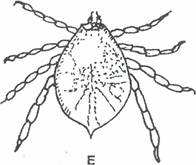|
Question 4
|
(a) The diagrams labelled 0 and E below show some animal parasites.
 
D
Study them carefully and answer the questions that follow:
(i) Name the animal parasites labelled 0 and E. [2 marks]
(ii) Mention one primary host and one secondary host of the
parasite labelled D. [2 marks]
(iii) State two ways of controlling the parasite labelled E.
[ 2 marks]
(b) A poultry farmer had 600 layers in lay. After an initial high monthly collection of eggs,
the farmer observed a rapid decline in production.
The farmer's observation is as shown in the table below.
Egg Production Records
Month |
January |
February |
March |
April |
May |
June |
July |
August |
Total number of |
16,800 |
17,700 |
16,200 |
13,500 |
11,250 |
9,150 |
9,000 |
8,400 |
eggs collected per |
|
|
|
|
|
|
|
|
month |
|
|
|
|
|
|
|
|
Study the table carefully and answer the questions that follow.
(i) Determine the percentage drop in egg production from February to March. [ 2 marks]
(ii) Suggest four possible causes of the rapid decline in egg production from April to August. [4 marks]
(iii) State three characteristics of the layers that the farmer could use to cull out the unproductive ones from the flock. [ 3 marks]
|
| _____________________________________________________________________________________________________ |
|
This question was fairly attempted by the candidates. In question 4 (a)(i - iii), many candidates
were able to identify the animal parasite labelled E(Tick) and state ways of controlling the
parasite.
However, most of the candidates could not identify the parasite labelled D(Liver fluke) and
mention the primary host and secondary host of the parasite
Further to this, in question 4(a)(i-iii) majority of the candidates were unable to determine the
percentage drop in egg production from February to March. Neither could they suggest
possible causes of the rapid decline in egg production from April to August. Also, they could
not state the characteristics of the layers that the farmer could use to cull out the unproductive
ones from the flock.
The expected answers include:
Name of animal parasites labelled D and E
D - Liverfluke
E - Tick
Primary and Secondary hosts of the parasite labeled D
- Primary host - Cattle/sheep
- Secondary host - Water snail (Umnea trunculata)
Determination of the percentage drop in egg production from February to March
- February - 17,700 eggs
- March - 16,200 eggs
17,700 - 16,200 x 100
17,700 1
1500 x 100 = 8.47%
17,700
Possible causes of the rapid decline in egg production from April to August
- Consumption of poor quality feed
- Inadequate feed supply
- Disease conditions
- Poor lighting system
- Inadequate feed additives to stimulate egg production
- Poor housing system
- Cannibalism/egg pecking
- Pest infection
- Poor laying stocks
- Inadequate water supply
- High noise level
- Poor sanitary conditions
- Overcrowding leading to competition for feed
- Mortality occurring during the period
- Ageing flock
- Stealing by poultry attendants
Characteristics of layers that the farmer could use to cull out the unproductive birds
- Birds with dull, dry shriveled scaly comb
- Pale, dry, poorly developed wattles
- Yellowish tinted and dull eyes
- Shrunken, dry and puckered cloaca/vent
- Aggressiveness
- Contracted, hard and fleshy abdomen
- Tendency to lay peewee eggs/small eggs
- Thick skin underlaid with fat
- Tendency to brood/broodiness
- Pubic bones blunt, rigid and close together
- Yellow eye ring and ear lobe
- Yellow beak
- Yellow and round shanks
- Plumage are not ruffled.
- Early and slow moulting
- Cannibalistic traits
- Poor daily egg production rate
- Poor feed conversion efficiency
|
|
|
|



